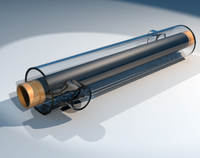
Photo from wikipedia
The results of direct measurements of turbulent fluxes at Bellingshausen station (the Antarctic) in the summer of 2002, 2003, 2007, and 2009 are considered. The features of energy exchange are… Click to show full abstract
The results of direct measurements of turbulent fluxes at Bellingshausen station (the Antarctic) in the summer of 2002, 2003, 2007, and 2009 are considered. The features of energy exchange are studied for these seasons. The interannual and intraseasonal variability of energy exchange characteristics is investigated. It is found that heat fluxes depend on the surface state and on the wind direction. Also, as a rule, they have a clear diurnal course with negative or near-zero values at night and with positive values in the daytime, when intensive convective fluxes are observed over open ground. The momentum flux is defined by the wind direction and wind speed and by stratification conditions. The main factors affecting energy exchange between the atmosphere and the surface in the Antarctic coastal zone are synoptic conditions and the surface state (snowless season duration and moss cover presence).
Journal Title: Russian Meteorology and Hydrology
Year Published: 2020
Link to full text (if available)
Share on Social Media: Sign Up to like & get
recommendations!